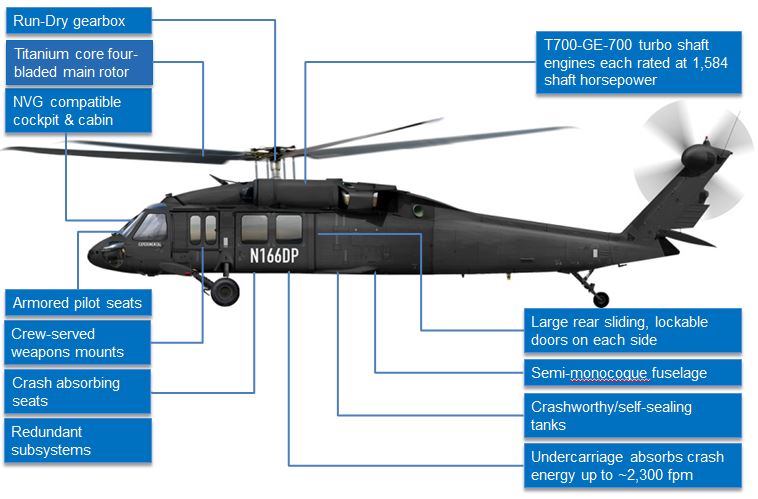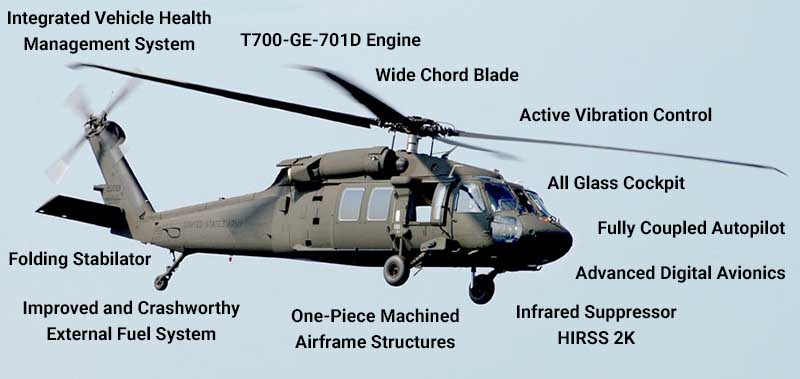What Makes the UH 60 Helicopter a Key Property for Tactical Airlift Procedures
What Makes the UH 60 Helicopter a Key Property for Tactical Airlift Procedures
Blog Article
UH-60: Technologies in Modern Helicopter Style
The UH-60 helicopter stands as a criteria in modern aviation, showcasing considerable improvements in layout and technology that provide to the progressing needs of army operations. As we check out the development and essential innovations of the UH-60, it comes to be necessary to consider exactly how these growths affect not just existing applications yet additionally the future landscape of helicopter style.

Evolution of the UH-60
The evolution of the UH-60 Black Hawk helicopter stands for a significant turning point in aerospace design and armed forces air travel. Presented in the late 1970s, the UH-60 was designed by Sikorsky Airplane to meet the USA Military's need for a versatile utility helicopter with the ability of doing a variety of objectives. Its layout emphasized ability to move, toughness, and rate, setting brand-new standards for functional efficiency.
The UH-60 features an unique four-blade blades system, which boosts lift and security, permitting it to operate successfully in diverse atmospheres. Its airframe is created from innovative composite materials, adding to a decrease in weight while maintaining structural integrity. The helicopter's style also includes better the rules of aerodynamics, which improves fuel effectiveness and raises range.
For many years, the Black Hawk has gone through several upgrades to boost its abilities, including improved engines, advanced flight control systems, and modular systems for easy maintenance and flexibility. The helicopter's ability to perform missions varying from army transportation to clinical evacuation has actually strengthened its duty as a backbone of U.S. military procedures. The UH-60 Black Hawk remains an archetype of how advancement in helicopter style can considerably impact military efficiency and functional flexibility.
Advanced Avionics Systems
Developments in avionics systems have transformed the capacities of modern helicopters like the UH-60 Black Hawk, enhancing functional effectiveness and situational awareness (UH 60). The assimilation of innovative avionics permits improved flight, navigating, and communication administration, making the UH-60 more functional in varied objective accounts
Among the essential attributes is the sophisticated digital cabin, which utilizes multifunction display screens that offer real-time information, making sure pilots have immediate accessibility to important flight information. This streamlining of info reduces pilot work and enhances decision-making procedures throughout complicated operations. In addition, the consolidation of GPS and inertial navigating systems allows precise positioning and path preparation, boosting goal execution in difficult atmospheres.
Moreover, advanced avionics systems enhance interaction abilities with secure information web links and voice communication systems, permitting smooth sychronisation with ground forces and other aircraft. The combination of automatic flight control systems better contributes to improved security and control, specifically in adverse climate condition or during low-altitude maneuvers.
Engine and Performance Enhancements
Engine efficiency in contemporary helicopters has taken a substantial jump ahead, driven by innovations that increase power, effectiveness, and dependability. At the forefront of these advancements is the fostering of more powerful turboshaft engines, specifically those employing sophisticated products and technologies that make it possible for greater temperature tolerances and boosted thrust abilities. The UH-60 Black Hawk, as an example, makes use of the T700-GE-701C engine, which includes a dual-channel, full-authority electronic engine control system. This system improves efficiency while maximizing gas intake and lowering maintenance requirements.
Moreover, the assimilation of engine health and wellness monitoring systems enables real-time diagnostics and anticipating maintenance, significantly boosting operational integrity. These systems not only alert staffs to potential problems before they end up being crucial however also facilitate more reliable maintenance organizing, thus decreasing downtime.

Materials and Structural Innovations
Recent growths in materials and architectural design have actually revolutionized modern helicopter building and construction, enhancing both efficiency and toughness. The introduction of sophisticated composite products, such as carbon fiber strengthened polymers, has significantly reduced weight while maintaining architectural honesty. This shift not only enhances gas effectiveness yet Home Page likewise increases haul capability, allowing helicopters like the UH-60 to perform even more varied missions.
In addition, innovations in aluminum alloys and titanium elements have contributed to enhanced resistance to deterioration and fatigue, extending the life-span of critical airframe components. The strategic use these products has brought about a decrease in maintenance requirements and boosted overall operational readiness.

In addition, the assimilation of computer-aided layout (CAD) and additive manufacturing technologies has actually made it possible for more light-weight structures and complicated geometries, enhancing the aerodynamic performance of helicopter styles. These innovations facilitate rapid prototyping and production, allowing makers to react swiftly to developing objective needs.
Security and Survivability Functions
Safety and security and survivability functions in modern helicopter layout have come to be critical, showing the increasing needs for objective efficiency in challenging atmospheres. The UH-60 Black Hawk, a remarkable instance, integrates sophisticated technologies to boost staff and passenger defense. Among one of the most essential innovations is the consolidation of crashworthy fuel systems developed to minimize the risk of fire throughout effect. In addition, the airframe is created with reinforced products that dissipate and take in energy, more shielding passengers in the event of an accident.
The helicopter likewise utilizes a ballistic security system, that includes armored team seats and important systems protecting, reducing susceptability to tiny arms fire and shrapnel. Enhanced situational understanding is accomplished with advanced avionics and sensor technologies, permitting pilots to discover my response and stay clear of threats effectively.
Furthermore, the combination of redundancy in critical systems-- such as double engines and multiple trip control channels-- guarantees ongoing operation even if one system fails. The UH-60 is equipped with sophisticated emergency flotation tools, enhancing survivability in water touchdowns. Jointly, these attributes not just boost the safety and security of personnel yet additionally raise mission success prices in aggressive environments, showing the commitment to quality in helicopter style.
Final Thought
The UH-60 helicopter represents a significant innovation in modern air travel innovation, integrating cutting-edge materials, sophisticated avionics, and robust safety attributes. Generally, the UH-60 serves as a benchmark for future growths in helicopter style, symbolizing strength and adaptability original site in modern army operations.
The UH-60 helicopter stands as a criteria in modern-day aviation, showcasing considerable improvements in style and technology that cater to the advancing demands of armed forces operations. As we check out the evolution and crucial innovations of the UH-60, it ends up being important to take into consideration exactly how these advancements affect not just existing applications but likewise the future landscape of helicopter layout.
Introduced in the late 1970s, the UH-60 was developed by Sikorsky Airplane to satisfy the United States Army's requirement for a versatile energy helicopter qualified of doing a variety of missions. The UH-60 Black Hawk stays a prime example of how advancement in helicopter style can dramatically influence armed forces efficiency and operational adaptability.
Generally, the UH-60 serves as a standard for future developments in helicopter style, personifying strength and versatility in modern army operations.
Report this page